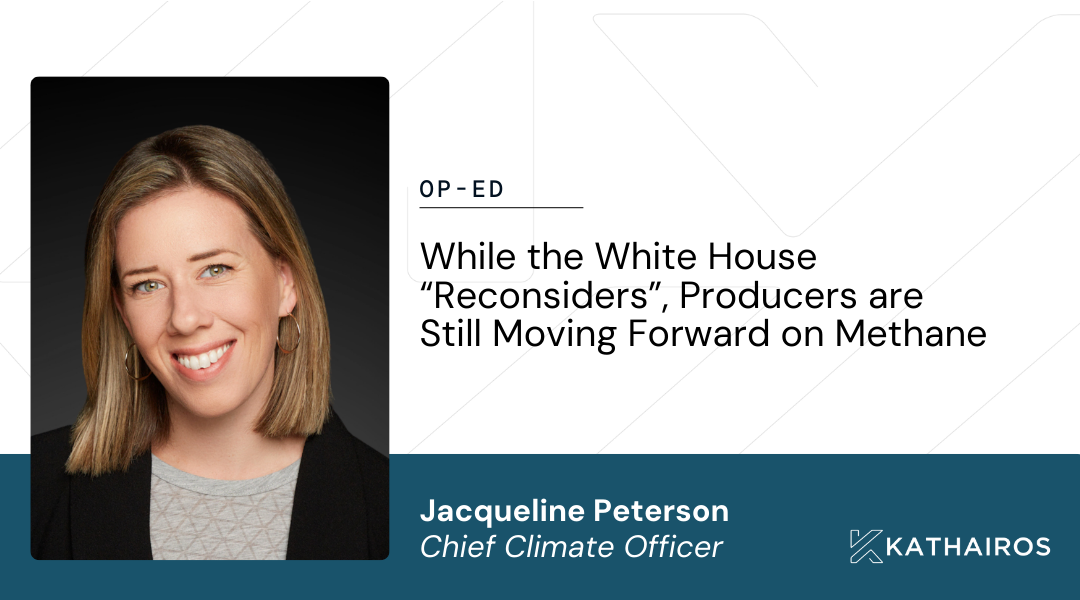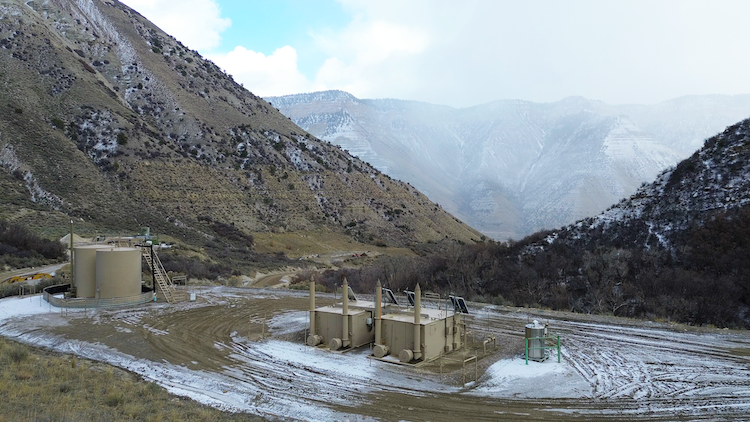
Kathairos has emerged as the leading North American solution for methane elimination from pneumatics, with more than 1,000 systems in operation across North America and over 40 major oil and gas producer partners.
In this post
Gas leaks from industrial processes contribute three times the amount of greenhouse gas emissions as global air travel. These leaks, known as fugitive emissions, are mostly methane – an odorless gas invisible to the naked eye, often released through outdated methane gas vent pipes, with the potential to trap 72 times more heat in the atmosphere than CO2 over a 20-year period.
You might be saying, “Why not fix the leaks and solve the methane problem? That’s a 50-year problem I solved in less than a minute, just like that!” Well, leaks are just one part of a much, much bigger picture that also includes inefficient methane gas venting systems, which compound the issue.
Methane emissions, stemming largely from the production and combustion of fossil fuels in both the oil and gas and transportation industries, are even worse than previously understood. This makes one thing very clear: methane emissions reduction will be crucial in reaching environmental targets and mitigating the effects of climate change.
The goal of limiting global warming below 1.5°C outlined in the Paris Agreement cannot be achieved without reducing methane emissions by at least 40% by 2030. We need to act on methane now before it’s too late.
The good news is, we know exactly how to do it.
So… what’s stopping us?
THE BATTLE AGAINST METHANE IN THE WAR ON CLIMATE CHANGE
To know how to begin addressing the methane problem, we should first be clear on what methane is and what makes it such a power player in climate change. Simply put, methane is a colourless and odourless gas found in nature and created as a product of certain human activities.
Methane is one of the most potent greenhouse gases. It accounts for around 17% of global greenhouse gas emissions and is responsible for at least 25% of the current warming we experience. What makes it so potent? Methane will cause more warming relative to the same amount of CO2 over a given period of time, mainly due to two factors: its heat trapping potential and its lifetime in the atmosphere.
Methane traps heat 72x better than CO2, but why? It has to do with its unique ability to trap molecules vibrating at frequencies other than the frequencies CO2 can trap. On top of this, there is significantly less methane in the atmosphere than CO2, with one methane molecule persisting for every 200-400 molecules of CO2. This means that the additive effect of methane on global warming is much greater when compared to CO2. Even further, when you take into account the fact that methane only exists in the atmosphere for 12 years before breaking down into CO2 and water, it becomes even clearer that methane’s short-term effect on global warming is particularly greater than CO2, which becomes a more important player in the long-run.
Let’s put it this way: methane may not get on the podium after a marathon like CO2, but you can be sure to see it running beside Andre De Grasse in the 200m sprint.
Methane’s short atmospheric shelf life is precisely what makes it an easy target in the fight against climate change. If the Paris Agreement targets do in fact manage to reduce global methane emissions by 40-45%, this would avoid nearly 0.3°C of warming by 2045 and help us immensely in long-term climate change mitigation efforts.
If we can address these fast-acting greenhouse gases and win the battle against methane today, then we may just have a fighting chance to win the war against CO2 and long-term climate change tomorrow.
FUGITIVE EMISSIONS: THE REAL PROBLEM
Where does methane come from? While there are natural sources, such as the decay of plant material in wetlands and the seepage of gas from underground deposits, the emissions we are interested in come from human activity. Three industries stand out in particular: agriculture, which accounts for 40% of global methane emissions; fossil fuels, which account for 35%; and waste, which accounts for 20%.
Methane from fossil fuels and energy production represents the most potential for reduction, and because captured methane can actually be sold in the global carbon credit market, many reduction measures in this industry would be low-cost, zero-cost or even profitable! In 2020, global methane emissions from fossil fuels totaled approximately 72 megatonnes – this is more than Russia’s entire carbon footprint. A lot of these emissions come as fugitive emissions, or leaks that occur as a result of industrial processes.
Fixing these leaks could be as simple as turning a wrench or replacing a panel. The challenge? Finding the leaks. Oil and gas companies have long depended on infrared cameras and handheld sensors to identify leaks, which are both time-consuming and expensive. The result? Companies do not check for leaks continuously and only do so periodically, meaning that leaks can be left undetected for several months at a time.
While leaks are a major issue, the majority of methane emissions from fossil fuels are deliberate, coming from safety and pipeline maintenance or as an unwanted by-product. Some of this methane is vented directly into the atmosphere, while much of the rest is flared or burned off, to convert it to CO2 and water. However, many flares have been found to be faulty or inefficient, allowing methane gas to escape into the atmosphere. These emissions represent both an environmental and economic concern.
In the U.S. alone, roughly $2 billion of natural gas is vented, flared or leaked each year. That’s enough natural gas to power more than 10 million homes for an entire year! Considering that roughly $34 billion of natural gas is wasted annually worldwide, it becomes very clear that methane mitigation represents both an environmental and economic win.
LACK OF INCENTIVE, LACK OF PROGRESS
So, what’s stopping oil and gas companies from reducing their emissions? For one, companies often lack the financial or regulatory incentives to cut their methane emissions further than what is necessary. In addition, many wells aren’t connected to a natural gas pipeline, since that’s not their intended product. This means that a lot of associated gas remains stranded at well sites, with no pathway to market.
An even bigger challenge? Bad data. Methane emissions are notoriously difficult to measure, quantify and keep track of because of imprecise and expensive detection technologies. In fact, there was virtually no data to work with merely a decade ago, when methane emissions from the oil and gas industry started to be monitored. Nobody clearly understood the methane problem. Companies have long relied on paper calculations to best estimate how much methane they were emitting, leaving room for a great deal of error.
In 2018, the Environmental Defense Fund revealed that methane emissions were 60% higher than estimates conducted by the Environmental Protection Agency. Inaccurate data makes it difficult to decide effective regulations, to combat leaks and to hold companies accountable for their emissions.
However, not all hope is lost. From remote sensors that continuously monitor for leaks to more precise air surveys using drones, emerging technologies and clean tech start-ups are beginning to provide more accurate and timely data to oil and gas companies, while also incentivizing the adoption of such strategies through lower service costs. Almost 70% of fossil methane can be abated using technology and solutions that are available today.
These technologies are opening doors for better regulation and are providing a clearer picture of the patterns behind greenhouse gas emissions, which is a big part of the problem to address. Once found, methods to prevent and reduce methane emissions are already well-established. For example, associated gas can be captured rather than vented, leaky parts can be replaced and consistent maintenance can keep the systems sealed and highly efficient.
One thing is certain. The tools are available. The industry just needs to use them – voluntarily or under regulation.
REGULATION: THE WAY FORWARD
Many companies have already voluntarily committed to reduce their methane emissions. For others, reduction represents the only viable way forward, as support for a greener future and more environmentally conscious operations grow increasingly stronger by the day. In fact, the European market is already discussing the adoption of a methane intensity standard for any imported natural gas, which provides a strong economic incentive for suppliers to take a look at their production methods.
While voluntary action is a good start, it’s not enough on its own. That’s where regulation comes in.
There’s no one-size-fits-all policy to keep methane emissions in check, as there are plenty of different approaches to the problem. Regulators could force companies to abide by certain practices, such as mandating the replacement of leaky components or mandating the collection of associated gases instead of venting.
Similarly, well sites could be required to plug into or build a natural gas pipeline to reduce venting and flaring. Regulation could also set a cap on emissions, but in order to hold companies accountable, regulators will need to know how much methane these companies are emitting on a continuous basis, which again… requires better data.
Finally, a price on methane, like a carbon tax, has proven effective in incentivizing companies to reduce emissions as a way to avoid financial penalties.
It will take time for energy grids to wean off of carbon-intensive fossil fuels. The worst emitters, like coal, have to go first. More than 40 countries have already signed an agreement to phase out coal production and use as a climate action priority at COP26 last year.
In the meantime, there’s good reason for optimism in the methane front. We already have the ability to address the problem, we just need to be more vigilant and triple down on making sure that methane reduction actually happens.
Can we do it? Absolutely. Will we do it? Here’s hoping.
Explore more posts from Kathairos
.jpg)
Decarb Digest, Issue 01: Discover Why Energy Leaders Aren’t Waiting on Washington

Op-Ed: While the White House “reconsiders”, producers are still moving forward on methane

